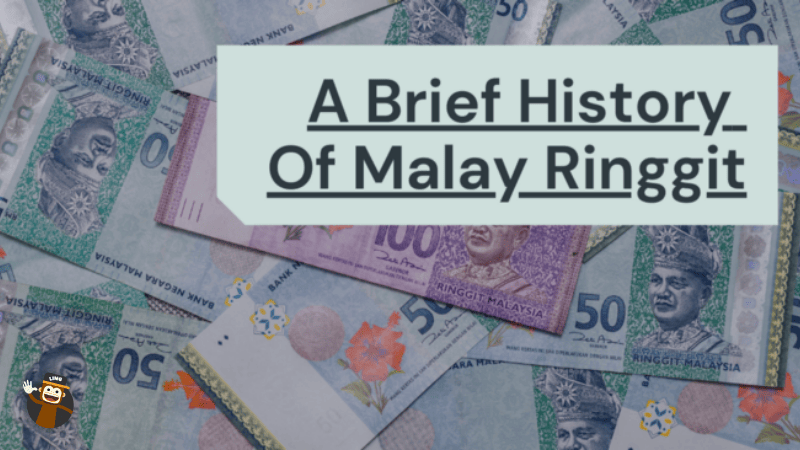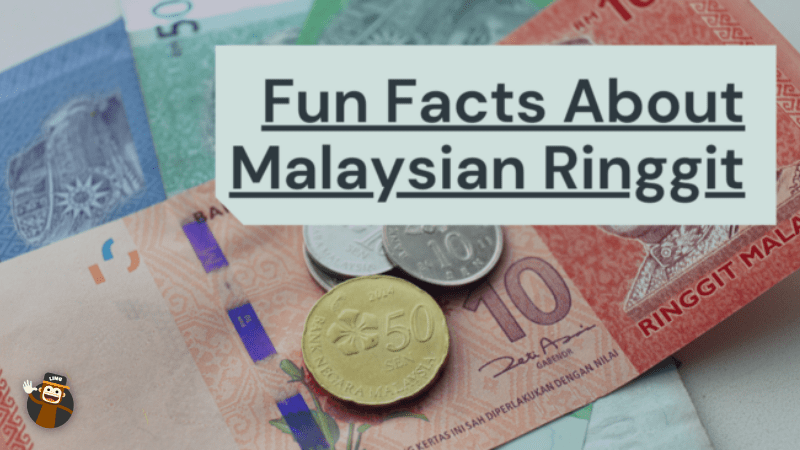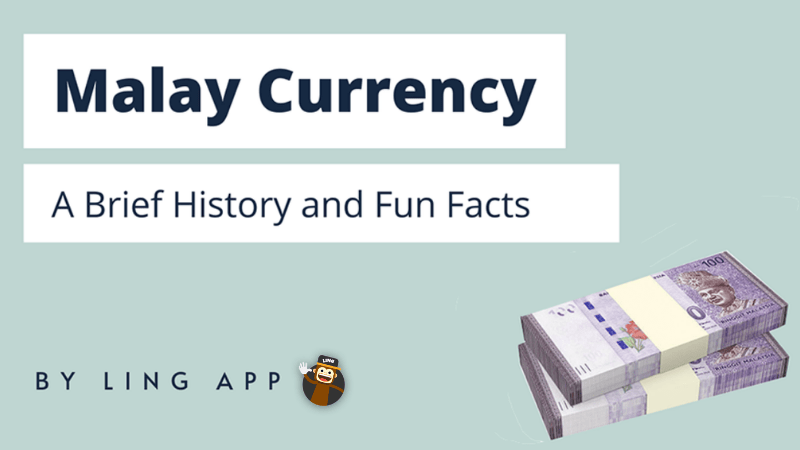You’ve been studying Malay for a while now, and it’s finally time to show off your skills and let natives know just how much you’ve learned! So, naturally, you start planning a trip. But how much do you know about the Malay currency? Malaysia is a country that many are dying to visit. It is exciting, full of beautiful natural landscapes, diverse cultures, and delicious food. With over 60 ethnic groups, lots of traditions for visitors to explore, lively cities, and breathtaking beach resorts – there is something to suit everyone’s needs.
Are you interested in tasting the sumptuous flavors of Malaysia? Before you select a date and purchase your ticket, let’s all face the truth. Whether we admit it or not, most are concerned with staying within our budget while traveling. To do that, one of the absolute musts before traveling is to get familiar with the official currency of your target destination.
A Brief Introduction To Malay Ringgit
The Malaysian ringgit (currency code: MR, currency symbol: MYR) is the official Malaysian currency and has been so since 1967. It is also among the nine most traded major currencies in the world. That is because it is an easy-to-use and stable currency with high convertibility.
The various denominations of paper notes in circulation in Malaysia fall into four categories: RM1, RM5, RM10, and RM50. The largest denomination is RM100, the highest denomination among all countries in the region. Ringgit is subdivided into 100 sen. Unlike the ringgit, the sen comes only in coin form and is available in denominations of RM1, RM5, 1RM0, RM20, and RM50.
Why Is The Malaysian Currency Called Ringgit?
When the Spanish held sway over the region, the main coins used for trade were the “pieces of eight” we commonly associate with tales of pirates sailing the east under the insignia of the skull-and-crossbones. The coins had jagged edges, and the word for jagged in Malay was “ringgit.” The term soon lost its original meaning, and ringgit has since been used exclusively as a word for currency.
A Brief History Of Malay Ringgit

Throughout history, currency has always been the main form of trade. It is also a way to send and receive goods and services. As a result, the currency has changed in response to the needs of society. The first set of banknotes in Southeast Asia was issued in 1826. and were circulated in the form of paper bills.
From the 16th to 19th centuries, international trade between the Americas and Asia was primarily conducted using the Spanish-American silver dollar. During the 19th century, the Spanish dollar was transformed into the British North Borneo, Sarawak, and Straits. These dollars split further, and the subsequent Malaya and British Borneo dollar would eventually become today’s Malaysian ringgit.
After World War 2, Britain wanted to establish a new currency to replace their declining pound Sterling, and they chose the Malayan dollar, which was pegged to Sterling at par.
Jump forward to June 12, 1967, and the replacement of the Malaya and British Borneo dollar with the much more named Malaysian dollar. As with many countries gaining independence, and taking control of their currency, one of the first things Malaysia did was to establish a central bank. The Central Bank of Malaysia decided to keep many of the attributes of the former currency, such as the color schemes on the notes and the denominations.
The Malaysian dollar remained on par with the Malaya and British Borneo dollar as Malaysia retained its membership in the sterling area, a group of nations that kept their currencies pegged to sterling. Unfortunately, in November 1967, the pound was devalued by nearly 15 percent, falling in value against the US dollar from US$2.80 to US$2.40. This led to a drop in confidence, and by 1972 the sterling area was no more.
The Interchangeability Agreement meant Singapore, Malaysia, and Brunei currencies were all exchangeable at par. However, the agreement was dissolved on May 8, 1973, when the Malaysian government decided to withdraw. Another significant change for the Malaysian currency was replacing the dollar sign with the currency symbol “M$.” Today the official currency symbol is “RM,” which stands for Ringgit Malaysia.
Banknotes And Coins Issued By The Bank Negara Malaysia

The first Malaysian dollar banknotes Malaysia issued were by the Central Bank of Malaysia on June 6, 1967. They featured a portrait of Tuanku Abdul Rahman, the first ruler of independent Malaya. The signature of the first Malaysian Governor of the Central Bank of Malaysia, Tun Ismail bin Mohamed Al, also appeared. A second series of banknotes was released in 1982 and featured traditional ornamental designs associated with Malaysia. In 1996 came a third series which included the addition of a hologram strip to make counterfeiting more difficult.
Although the designs have remained the same, a polymer RM5 banknote was issued, and the Central Bank of Malaysia said all paper notes would eventually be replaced with more durable polymer notes. Since then, the bank has issued a fourth series of letters with new designs intended to express themes associated with the idea of Malaysia. Among the commemorative banknotes are an RM50 polymer banknote to celebrate the 1998 Commonwealth games held in Kuala Lumpur and a 50 ringgit banknote issued with the country’s 50th Anniversary of Independence.
- The first ringgit banknotes consisted of notes with four values: RM5, RM10, RM50, and RM100. There were no coins at the time.
- The second series of ringgit banknotes was a bit more diverse. It consisted of six denominations: RM10, RM20, RM50, RM100, RM500 (also known as the “silver money”), and RM1000 (the famous “big money”).
- The third series of Malaysian banknotes come with a design similar to that of the first series.
- In the fourth and last Malaysian banknote series, only four types of banknotes were printed. There were notes denominated in RM10, RM20, RM50, and RM100, issued by the central bank, Bank Negara Malaysia.
The List Of Words You Need To Know
Money is a topic that many of us find difficult to talk about. In today’s society, money is not only a topic of conversation but can also be taboo. When we have something to say about money, the most crucial step is finding something comfortable to talk about and understanding the topic.
Therefore, we will do our best to cover the most common words related to money you might need if you visit Malaysia, so check out the table below and stay tuned!
| English | Malay |
| currency | matawang |
| currency symbol | simbol matawang |
| currency code | kod matawang |
| exchange rate | kadar pertukaran |
| exchange office | pejabat pertukaran |
| investment | pelaburan |
| economy | ekonomi |
| cost/costs | kos |
| stock/stocks | saham |
| value | nilai |
| price | harga |
| convert | menukar |
| bank | bank |
| buy | beli |
| sell | jual |
| ATM | mesin keluar duit |
| cash | wang tunai |
| denominations | kelas unit pengukuran |
| banknotes | wang kertas |
Fun Facts About Malaysian Ringgit

Are you ready for more? Now that you’ve armed yourself with knowledge about the Malay currency and its history let’s have some fun and check out some interesting facts about it.
Fun Fact #1: Ringgit Means “Jagged”
The Malaysian ringgit has a story behind it. In the old days, the Malaysian ringgit used to be known as “the jagged one.” The name came from the Spanish silver dollar, widely used during the Portuguese colonial era. Its name was derived from the unevenly cut edges of the coins.
Fun Fact #2: You Can Still Use Old 1 Sen Coins in Malaysia
The RM1 coin has been demonetized for quite some time now, but in case you’ve got a couple of them lying around, you might still be able to use them for payments up to RM2. The seller has a right to refuse them, but trying to use them for your purchase is legal.
Fun Fact #3: The RM1 Coin From 1989. Still Had A US Dollar ($) Sign
Even today, it’s not uncommon to hear someone describe the price of something in dollars. Sometimes, locals refer to the ringgit as dollars because it used to be called that way until 1975.
Fun Fact #4: Gold Coins Are Not Made Of Gold
They’re made of copper and zinc. Who would say?
Fun Fact #5: The Fourth Series Of Coins Has A Cool Security Feature
The last 20 and 50 sen coins set has an extra security feature. If you tilt a coin to its reverse side, it will reveal a latent image of the number 50 and the word “sen.”
Travel Money Guide To Malaysia
Now we have had a brief look at the history of Malaysian money, let’s look at the money essentials if you are thinking of visiting this wonderful country.
Currency Exchange
You will need to exchange the cash you arrive with for Malaysian ringgits. Use a currency converter so you are current on the latest exchange rates. All major tourist centers will have banks and exchange offices where you can convert the US dollar, Australian dollar, Japanese yen, etc. Although there is no fee for changing your money, the exchange rate may vary, so shopping around is a good idea. Always double-check your cash before leaving the bank or exchange office.
ATMs
All major cities have plenty of ATMs for you to withdraw Malaysian currency. They can be found in banks, shopping centers, gas stations, and streets. Maybank ATMs are the best known and can be identified by their distinctive yellow and black color.

Which Card To Take
Most of us will opt for credit, debit, and travel cards. Although cards are widely accepted around the country, there will be occasions when only cash is accepted. A good rule of thumb is to use a travel and debit card for everyday spending while reserving credit cards for emergencies, more significant purchases, or sending money.
Insurance
You should have comprehensive insurance coverage sorted before boarding your plane to Malaysia. Ensure it covers the essentials, including emergency medical and dental assistance, lost luggage, and missed flights and cancellations.
Learn Malay With Ling App
I think you’re ready for a new adventure after all this learning. But don’t forget to bring your phone and Ling App with you!
Ling App by Simya Solutions is an interactive language app that helps people learn almost any language. The application can teach you Malay but also supports Spanish, French, German, Mandarin, and many more languages.
There are three quick steps for getting started with Ling App by Simya Solutions: choose your desired language, start learning, and don’t forget to share it with friends! In the meantime, don’t forget to check out other articles on our blog and learn more before you hop on the plane.


































































